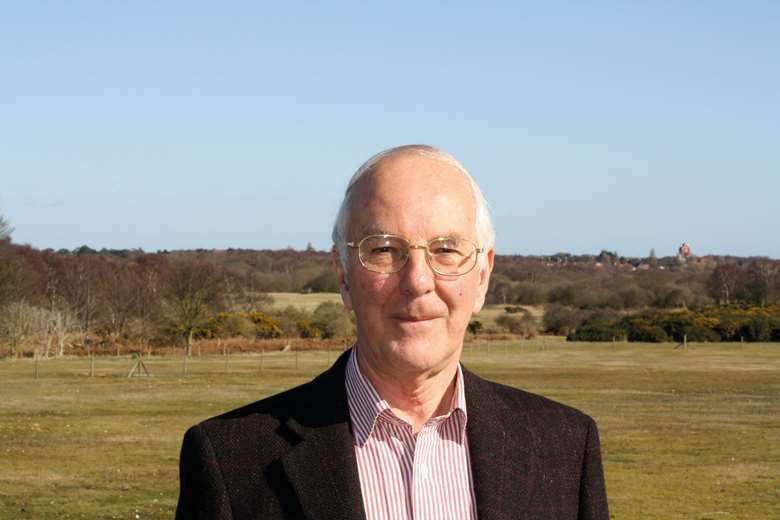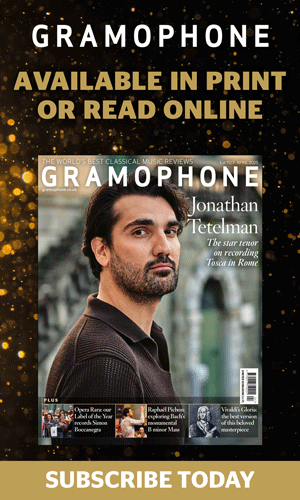Peter Dickinson, composer, writer and teacher, has died
Monday, June 19, 2023
We pay tribute to a long-time and much-valued Gramophone contributor

We are very saddened by the death of Peter Dickinson, composer, pianist, academic, teacher and long-time Gramophone writer. American composers remained a life-long specialism, while Peter's own music – much of which can be heard on recordings, including a recent series of well-received albums – ranged from the experimental to works drawing on jazz or ragtime, often weaving such styles together. His contributions to Gramophone's pages were a much valued part of how we explored and explained musical developments over several decades.
A few years ago Arnold Whittall celebrated Peter's music in our Contemporary Composer feature, while a few year before that Peter had marked his 80th birthday by joining James Jolly for a special edition of the Gramophone Podcast, both of which we republish below as a tribute.
Peter Dickinson in the Gramophone Podcast:
Contemporary Composer: Peter Dickinson
In 2018, Arnold Whittall profiled the English composer whose music bridges all manner of gaps in a positive embrace of diversity
A month after Peter Dickinson’s 80th birthday, Gramophone released a podcast (December 15, 2014) of a discussion between him and James Jolly which was printed in Dickinson’s latest book, Words and Music (Boydell Press: 2016). Reviewing Words and Music in these pages (3/18), Richard Whitehouse endorsed Dickinson’s own suggestion that his concertos for organ (1971), piano (1984) and violin (1986) (all now featuring on the same CD) ‘constitute his most important large-scale achievement and exemplify that resourceful integration of high art and vernacular elements which will likely prove his most enduring legacy’.
This pinpoints the bracing effect of Dickinson’s music in which allusions to the worlds of jazz or popular song can unobtrusively enhance those features of the ‘serious’ symphonic tradition that still predominate. Until recently, developments in the arts have often been seen by historians as exploring a single, crucial polarity – conservation versus innovation, qualities primarily associated with composers, painters, poets and all kinds of artistic creators. But a rather different polarity – populist versus elitist – is gaining favour today, and this shifts the emphasis from creators to consumers; from the considered concepts of artists to the instinctive preferences of audiences. In former times, audience members might be broadly categorised as highbrow, middlebrow or lowbrow, according to background and musical taste. Today, even the most experienced music critics are less confident about making such distinctions – especially when the elitist associations of ‘highbrow’ are no longer seen as automatically superior to the populist implications of ‘lowbrow’: and Dickinson’s music shows a comparable willingness to question the usefulness of such distinctions in the modern age.
In his review of Words and Music, Whitehouse follows up a cue from one of Dickinson’s most important pieces of writing when he describes a music ‘modulating between styles’ – ‘high art’ at one extreme, ‘vernacular’ at the other: a model allowing for many different kinds of transformations and confrontations. In Dickinson’s music such strategies reflect the spirit of Ives’s bracingly radical assertion: ‘Why tonality as such should be thrown out for good I can’t see. Why it should always be present, I can’t see.’ Ives is the most senior of the modernist pioneers valued by Dickinson. But respect for things Ivesian has always been complemented by the less expansive (but no less challenging) spirit of Satie – a conjunction possible because both Ives and Satie converged on a regard for the humanising immediacy of popular music, whether hymns, musical hall songs or the ‘swung’ qualities of ragtime, blues and (for Dickinson) the piano miniatures of Billy Mayerl.
From his earliest extant compositions, now well represented on disc, Dickinson has drawn strength from such well-varied contexts. When this Cambridge organ scholar graduated in the mid-1950s he might have been expected to move smoothly into a career as a cathedral organist and choirmaster, and a provider of church music in the Anglican tradition. That was not to be. But nor did Dickinson’s relish for the very un-English life of New York City while a graduate student at the Juilliard School lead to the kind of career mixing concert music, film scoring and jazz pianism which Sir Richard Rodney Bennett (two years his junior) would adopt a little later on. If Dickinson had stayed in America his openness to the experimentalism of Cage and his circle might have led to something as radical as Cage’s Satie-derived Cheap Imitation (1969). But Dickinson’s own Satie Transformations (1969-70), which, as the composer has said, ‘brings together straight and jazzed versions of material deriving from Satie’s Gnossiennes’, shows that working within a more mainstream environment than Ives or Cage can still produce sparkling and spontaneously expressive results.
Dickinson’s involvement in the rapidly expanding higher-education sector in Britain after 1960 stimulated the exploration of genres with a degree of community involvement, and what has proved to be his most substantial work, a 75-minute musical drama for student forces called The Judas Tree (1965), built around a text by Thomas Blackburn, fitted with the tendency to move ‘music theatre’ away from the opera house, as Britten and others were doing at the time. The survival of a (1967) recording of The Judas Tree from Washington National Cathedral, rather than from Canterbury or York, neatly pinpoints that degree of distancing from more local musical traditions that has remained a distinctive Dickinson feature down the years. Despite his progression through increasingly senior academic positions at the universities of Birmingham, Keele and London (Goldsmiths), his activities as performer, composer and writer signalled a pragmatic flair for fresh ways of responding constructively (which does not mean uncritically) to the kind of burgeoning stand-offs between elitism and populism to be found at their most elaborate in the concertos and the String Quartet No 2 (1975).
The repertoire included on the various recordings issued and reissued over the past few years fills out the coverage of how Dickinson has used vernacular allusions to give fresh point and purpose to those ‘high art’ qualities always at the heart of his musical language – qualities that acknowledge the example of his mentor Lennox Berkeley. Though comparable in some respects to Robin Holloway and David Matthews, and foreshadowing the likes of Mark-Anthony Turnage and Tansy Davies, Dickinson has shown resourceful commitment to his own special musical contexts, and two works from the 1980s are particularly memorable in this respect.
The Violin Concerto was written in memory of Ralph Holmes, a violinist with whom Dickinson often performed, and analogies with Berg’s concerto-as-instrumental-requiem are far from irrelevant. Dickinson offers notably edgy perspectives not just on Beethoven’s Spring Sonata (transformed at one point into a 1930s-style pop song) but also on the complex feelings of sadness and warmth that arise in remembering a valued colleague. Larkin’s Jazz (1989) is a more detached yet still affectionate tribute to a popular poet (Philip Larkin) whose musical preferences were refreshingly downbeat. Here Dickinson transforms what might have been a traditional kind of song cycle – four settings for baritone and instrumental ensemble often evoking the jazz of Sidney Bechet and King Oliver – into a continuous structure with 11 sections that involve speech as well as song. As the composer describes it, ‘Each poem has a prelude; then the poem itself is spoken to a minimal musical background; and that is followed by an instrumental commentary’ – to which a wordless baritone line may be added.
If the Walton/Sitwell Façade was an early demonstration of how the formidable Schoenbergian template of Pierrot lunaire could be moved away from expressionistic melodrama towards cabaret-style entertainment without losing all contact with ‘serious’ musical content, Larkin’s Jazz made a no less imaginative advance in generic rethinking decades later. And there are plenty of other Dickinson works that merit close attention. Mezzo-soprano Meriel Dickinson has recorded the strongly shaped early set of Auden songs (1956), along with other vocal works, for Albany, and a recording of the eloquently concentrated Violin Sonata (1961), written in America, is in the pipeline. But the concertos and Larkin’s Jazz convey the essence of the Dickinson idiom, avoiding extravagance and overstatement yet offering challenging superimpositions and juxtapositions that rarely settle into predictable, conventionally integrated modes of expression. With its direct, unfussy manner and positive embrace of diversity and even instability, this music epitomises crucial aspects of contemporary sensibility. If listeners today are still happy to categorise themselves as predominantly highbrow, middlebrow or lowbrow, Dickinson’s music has much to offer all of them.







